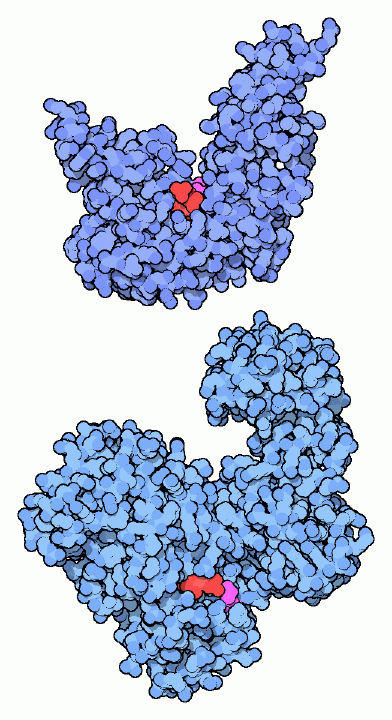|
Inhaltsübersicht | Nanomaschinen | Moleküle | Programme | Kurse | Fun | Links |
||
| > |
DNA Ligase

DNA Ligase
Human cells (with a few unusual exceptions) each contain their own set of 46 long strands of DNA. All of our genetic information is encoded in these strands, with thousands of genes strung along their length. The ordering of genes, and the proximity of one next to the other, can be important for the proper usage of the information, so it is important that our cells protect their DNA from breakage. If one strand in the DNA breaks, it is not a disaster, but it can lead to problems when the DNA double helix is unwound during the processes of transcription and replication. Breakage of both strands, on the other hand, is far more serious. To protect us from these dangers, our cells use DNA ligases to glue together DNA strands that have been broken.Breaking DNA
Environmental hazards can accidentally damage DNA. Ionizing radiation, such as gamma rays, attack the backbone of DNA and cause breaks. Our cells are also bathed with oxygen, a dangerous gas that forms reactive free radicals that attack DNA. Surprisingly, our cells also break their own DNA on purpose. During meiosis, the process where the genome is split into two halves for creation of egg or sperm cells, the DNA is often recombined. Portions of one DNA strand are cut out and traded with similar portions on a sister chromosome. Cells of the immune system also shuffle around their DNA strands, cutting out pieces and replacing them in a different location to build up a diverse collection of antibody genes. Gaps--breaks in one strand of the DNA--are also created when the DNA is replicated. Polymerases only work in one direction when they copy a DNA strand, so one of the two strands is copied in a series of small pieces that need to be linked up into a continuous strand.Repairing Broken DNA
DNA ligase reconnects DNA strands when they are broken. It uses a cofactor molecule (shown in red) for power and a special lysine amino acid (shown in magenta) to perform the reaction. Our DNA ligases and the DNA ligase from the bacteriophage T7 (shown at the top from PDB entry 1a0i) use ATP as the cofactor. Many bacteria, on the other hand, use NAD in the reaction, as with the DNA ligase shown at the bottom (from PDB entry 1dgs). In both cases, a lysine in the DNA ligase forms a bond to the phosphate in the cofactor, holding onto the AMP portion and discarding the rest. Later in the reaction, this AMP is transferred to the broken DNA strand, and then is released when the strand is rejoined.Gene Jockeys
DNA ligases are remarkably useful enzymes, inside cells and out. Along with restriction enzymes (see the Molecule of the Month on restriction enzymes), they have made the entire field of recombinant DNA technology possible. With these two types of enzymes, researchers can cut and paste DNA strands at will, designing new genes and new genomes. Restriction enzymes are like scissors, allowing us to cut DNA in specific places. DNA ligase then allows us to reconnect them into functional DNA strands. With this technology, we are now able to do for ourselves what cells have been doing for billions of years!Last changed by: A.Honegger,